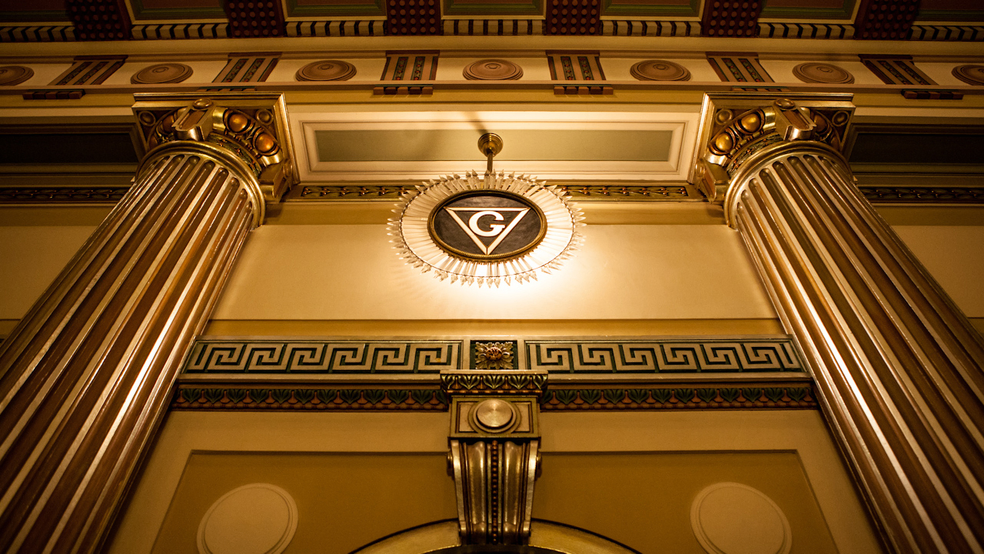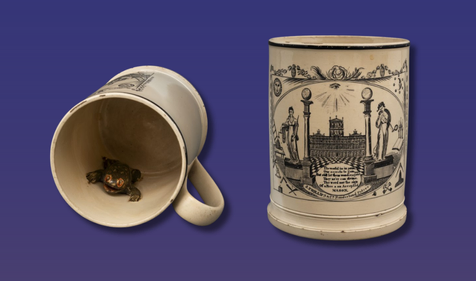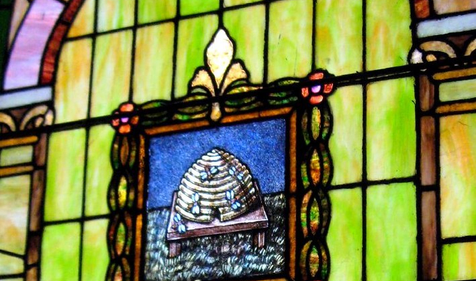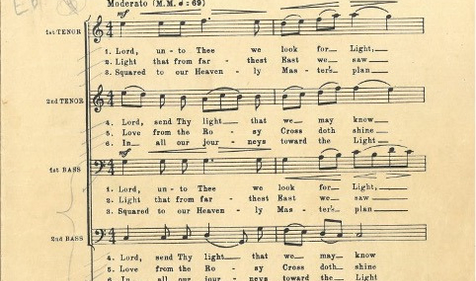In the Ancient Accepted Scottish Rite, Northern Masonic Jurisdiction, the responsibility of a Rose Croix chapter is to confer the 17° and 18°. The lessons within these degrees are rich, exploring the themes of philosophy, religion, ethics, and more.
The Chapter of Rose Croix confers the 17th and 18th degrees, known as the philosophical degrees. These degrees make use of Christian symbols and historical settings, but their spiritual message is universal for all Masons, who are united in the belief of a Supreme Being. Both degrees use the Book of Life to advance the concept of avoiding the mistakes of the past.
The term “Rose Croix” literally means “rose cross,” and is derived from the symbol of the order of the Rosicrucians: a rose on a cross. Aspects of the Scottish Rite’s 18th degree, Knight of the Rose Croix, were inspired by Rosicrucianism.
The degrees within the Chapter of Rose Croix are known for being among the most intellectually stimulating within the body of Freemasonry. In the Ancient Accepted Scottish Rite, Northern Masonic Jurisdiction, the responsibility of a Rose Croix chapter is to confer the 17° and 18°. The lessons within these degrees are rich, exploring the themes of philosophy, religion, ethics, and more. Fully comprehending these degrees can take years and is frequently considered one of the most rewarding parts of being a Scottish Rite Freemason.
Few degrees examine the topic of spirituality to the extent these two degrees do, making them among the most significant degrees in our fraternity. Before we expand on the degrees and the lessons therein, let us first reflect on the history of Rose Croix and its role in the evolution of Scottish Rite Freemasonry.
The Start of the Chapter of Rose Croix: Early History
The Chapter of Rose Croix started as a separate system of degrees decades before the first Supreme Council was formed. The early beginnings of our fraternity and this chapter were volatile, with competing interests and contradictory claims that make the story of the formation of the Chapter of the Rose Croix particularly muddled.
To provide a summary, despite the world’s first Supreme Council being founded in Charleston, South Carolina in 1802, the general organization of the higher degrees of Freemasonry in the United States was in disarray as late as 1813. Many prominent Masons had established competing higher bodies in New York City. In 1797, a Chapter of Rose Croix was formed in New York City by a group of Frenchmen. This was the first Rose Croix Chapter established in North America. Several other bodies appeared during this time which called for, in 1813, the Charleston Supreme Council (today known as the Supreme Council, Southern Jurisdiction in Washington D.C.) to investigate the various bodies for legitimacy. These bodies included Antoine Bideaud’s Sublime Grand Consistory.
With other bodies refusing to comply with the Supreme Council’s requests, Bideaud’s group was the only body to be formally recognized. This group and its founding members, notably Sampson Simpson, Daniel D. Tompkins, and Richard Riker, among other New York Masons, would become some of the first officers of the Supreme Council of the Northern Masonic Jurisdiction. The recognition of the Sublime Grand Consistory essentially brought forth the creation of the Northern and Southern Jurisdictions.
Years of turmoil between the Northern and Southern Jurisdictions would lead to variances in how the degrees of the Scottish Rite are bestowed upon members, including those of the Chapter of the Rose Croix, that remain to this day.
 Summons to Lodge St. Alexandre d'Ecosse, 1804. France. Courtesy of the Grand Lodge of Masons in Massachusetts Collection at the Scottish Rite Masonic Museum & Library, GL2004.0313
Summons to Lodge St. Alexandre d'Ecosse, 1804. France. Courtesy of the Grand Lodge of Masons in Massachusetts Collection at the Scottish Rite Masonic Museum & Library, GL2004.0313
The Chapter of the Rose Croix Around the world
Today, the degrees included in the Chapter of Rose Croix depend on the Supreme Council under which a Chapter operates. In France, Romania, Canada, and the Southern Jurisdiction of the United States, the Rose Croix consists of degrees 15 – 18. In the Scottish Rite, Northern Masonic Jurisdiction, the Chapter of Rose Croix is comprised of degrees 17 and 18. In the United Kingdom, the Rose Croix is the name by which the operating Scottish Rite bodies are called.
 Rose Croix Apron, 1830-1840. USA. Scottish Rite Masonic Museum & Library, Gift of the Supreme Council, 33º, Ancient Accepted Scottish Rite, Northern Masonic Jurisdiction, U.S.A., 74.1.48
Rose Croix Apron, 1830-1840. USA. Scottish Rite Masonic Museum & Library, Gift of the Supreme Council, 33º, Ancient Accepted Scottish Rite, Northern Masonic Jurisdiction, U.S.A., 74.1.48
While there is some variation in how Supreme Councils worldwide structure and administer the degrees, they all agree that the Rose Croix degrees are the spiritual center of Freemasonry and some of the most significant in the whole fraternity.
Rose Croix in the Scottish Rite, NMJ
The Seventeenth and Eighteenth Degrees are also known as the “Philosophical” or “Doctrinal” Degrees of the Scottish Rite. One can argue that the lessons conveyed in the Chapter of Rose Croix are more advanced than those taught in in Symbolic Lodge and the preceding Scottish Rite Degrees. Studying the book “Morals and Dogma,” a seminal volume of Scottish Rite understanding, can help provide the deeper meaning behind these degrees. Written by the former Sovereign Grand Commander of the Southern Jurisdiction, Albert Pike, “Morals and Dogma” offers a backdrop to each of the degrees. Jurisdictions around the world have utilized this resource as a starting point, if not use Pike’s writing in its entirety to inform their degrees (as seen in the Southern Jurisdiction.) In the Northern Masonic Jurisdiction, similarities can be found in Pike’s interpretation with today’s presentation of the 17° and 18°, though they are not identical.
 Most Wise Master Jewel Owned by Winslow Lewis, ca. 1863. Scottish Rite Masonic Museum & Library, Museum Purchase, 2020.028
Most Wise Master Jewel Owned by Winslow Lewis, ca. 1863. Scottish Rite Masonic Museum & Library, Museum Purchase, 2020.028
In the Northern Masonic Jurisdiction, a Chapter of Rose Croix has the responsibility to confer the 17° - 18°. They are deeply spiritual and religious yet do not subscribe to a particular dogma, though they were originally intended as such in the early days of our fraternity. Over time they have been revised and, today, leverage a Christian backdrop as a means to convey the message of Love and Sacrifice of one’s self for the benefit of the greater good. Both degrees use the Book of Life to advance the concept of avoiding the mistakes of the past and promote the lessons of Faith, Hope and Charity. While these degrees require deep reflection and study, here is a brief summary of their ethical teachings:
- 17th Degree - Knight of the East and West: The degree dramatizes a picture of human failure and social and moral behavior. It teaches that loyalty to God should be Man's primary allegiance and that we must seek truth in our way of life while learning not to repeat the errors of the past. Core Values: Reverence for God & Service to Humanity.
- 18th Degree - Knight of the Rose Croix of H. R. D. M.: In this degree, the teachings of Jesus of Nazareth are used to exemplify the universal principles of life. The core lesson is to be virtuous, endeavor to eliminate vice, and practice tolerance and love, particularly as it relates to the faith and creed of others. The 18° teaches that life and its strengths come from God. Core Value: Integrity
It must be emphasized that while the settings of these degrees may be Christian, their meaning must be interpreted based on the faith of the individual. Their message should resonate with all men: that fellowship may include all men regardless of their nation, race, or creed. The philosophies at the core of the Chapter of Rose Croix require careful study to unlock, but there is little doubt that the rewards to be gained through the journey are well worth the effort.
Related Stories
Discover additional Scottish Rite blogs and news on this topic.
-
A Jolly Masonic Mug
History
Read More about A Jolly Masonic Mug
-
What Does the Beehive Mean in Freemasonry?
Degrees
Read More about What Does the Beehive Mean in Freemasonry?
-
Official (and Unofficial) Music for the 32nd Degree
History
Read More about Official (and Unofficial) Music for the 32nd Degree



